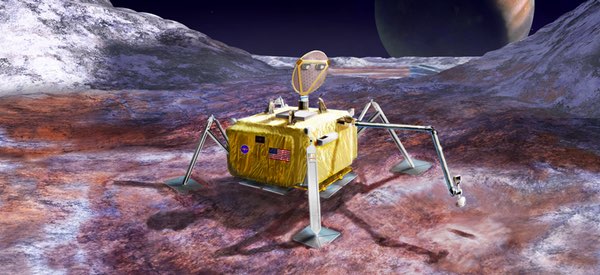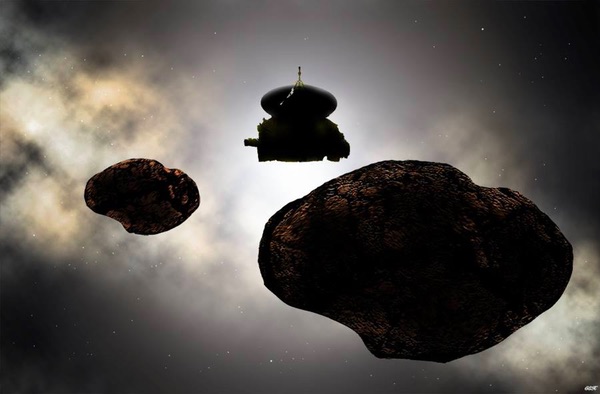The past and future of outer solar system explorationby Jeff Foust
|
| “From many points of view, Voyager really represents humanity’s most ambitious journey of discovery, and that’s what really I think is its legacy,” said Stone. |
But last week, while preparing for the end of Cassini, NASA also celebrated two long-lived explorers of the outer solar system. September 5 marked the 40th anniversary of the launch of Voyager 1. (Voyager 2 launched more than two weeks earlier, but on a different trajectory that caused it to arrive after Voyager 1 at Jupiter and Saturn.) With the two spacecraft still healthy, and in the case of Voyager 1 already in interstellar space, it was an opportunity to celebrate.
“From many points of view, Voyager really represents humanity’s most ambitious journey of discovery, and that’s what really I think is its legacy,” said Ed Stone, longtime Voyager project scientist and former director of the Jet Propulsion Laboratory. He spoke on a panel at an event September 5 at the National Air and Space Museum to mark the 40th anniversary of the Voyager missions.
The scientific legacy of the Voyagers is well known: a detailed reconnaissance of Jupiter and Saturn and the first—and to date only—close-up views of Uranus and Neptune, and their moons. The spacecraft are still working today, measuring magnetic fields and particle environments near or just beyond the boundaries of the solar system.
“Voyager, time and time again, caused us to greatly expand what we thought we knew about planets, what we thought we knew about rings, what we thought we knew about magnetic fields, what we thought we knew about moons,” Stone said. “It’s just changed and created a legacy of discovery now for many future missions to the outer planets.”
There have been, though, few future missions to the outer planets since Voyager. Galileo studied Jupiter for years before ending its mission in 2003 with a plunge into Jupiter, again to protect against contaminating a moon of astrobiological interest, Europa. Juno is currently orbiting Jupiter and will likely continue operating for a few more years, its mission extended in part because the spacecraft has remained in a longer orbit around the planet.
Then there’s New Horizons. The spacecraft completed its prime mission with the July 2015 flyby of Pluto. Now on an extended mission, the spacecraft team is turning its attention to another flyby, of the Kuiper Belt object 2014 MU69 on New Year’s Day 2019.
Last week, the New Horizons team announced that it plans to fly the spacecraft relatively close to MU69: a close approach of just 3,500 kilometers on the “nominal” trajectory past the object. An alternative, more distant flyby would bring the spacecraft no closer than 10,000 kilometers should observations detect the presence of debris or other hazards in the immediately vicinity of MU69.
“After a long ten weeks of trade studies, we’re able to put both trajectories closer to MU69, and confidently so, than we could fly to Pluto,” said Alan Stern, principal investigator for New Horizons, said at a September 6 meeting of the Outer Planets Assessment Group (OPAG) in California. New Horizons’ closest approach to Pluto, by comparison, was about 12,500 kilometers. That close approach will enable higher resolution images and other data, he noted, important given MU69 is far smaller than Pluto.
Flyby observations will begin in August 2018, Stern said, and run through the first week in January. “And then we will spend approximately 20 months shipping all that data back,” he said, at slower data rates than the Pluto flyby because of the greater distances involved.
MU69 itself—Stern promised “we will get a better name” for the object than its current designation before the flyby—is still something of an enigma. “About the only physical measurements we had of it until recently were its magnitude and its color,” he said.
However, the Hubble Space Telescope has been able to perform very precise photometry of the object, showing little variation in brightness as it rotates. “It either means that the object is not presenting vastly different cross-sections to us as it rotates, or we’re looking down the barrel of the rotation axis,” he said.
There was also this summer a coordinated campaign of observations of several stellar occultations, where MU69 passed in front of a star. Astronomers, equipped with portable telescopes, set up in South Africa and Argentina to observe the events, requiring significant planning. “It was like the Normandy invasion,” Stern said of those efforts.
On July 17, five teams of astronomers, spread out over a remote region of Patagonia in Argentina and with significant support from local officials, captured data from one such occultation. Initial analysis suggests that MU69 may be an unusual object.
“What we expected, of course, was just an ellipsoid,” Stern said. “What we got looks like either a double-lobed object or two objects—a binary—orbiting one another that just happen to be overlapping at the time of this event. Either way, it’s exciting.”
The flyby of 2014 MU69 is just part of New Horizons’ extended mission that runs through 2021. The spacecraft will perform more distant observations of dozens of other Kuiper Belt objects and also heliophysical studies.
| “I think New Horizons has a bright future, continuing to do planetary science and other applications,” Stern said. “There’s fuel and power onboard the spacecraft to operate it for another 20 years.” |
Stern is optimistic that this extended mission will not be the last for New Horizons. The lack of features in the lightcurve of MU69, he said, means that the spacecraft won’t need to maneuver as much to optimize the flyby trajectory. “It doesn’t matter where in the rotation phase we show up,” he said. “We’re going to see about the same amount of terrain.”
That frees up fuel reserves on the spacecraft, he said, that could be used to target another Kuiper Belt object flyby in a second extended mission that would run out to 2024 or beyond. “We are currently searching for new close flyby targets, and we have some very promising techniques” for doing so, he said. With the fuel reserves not needed for the MU69 flyby, “we have a fighting chance of having a second KBO flyby.”
There are also opportunities, he said, for additional remote observations of Kuiper Belt and other objects, distant observations of the giant planets, and heliospheric and even astrophysics studies using the spacecraft. “I think New Horizons has a bright future, continuing to do planetary science and other applications,” he said. “There’s fuel and power onboard the spacecraft to operate it for another 20 years. That’s not going to be a concern even for a third or fourth extended mission.”
 An artist’s concept of a proposed lander on the surface of Europa. NASA is looking at alternatives that could be less capable, but also less expensive, than this design. (credit: NASA/JPL-Caltech) |
Revisiting Europa
But what about the worlds of the more inner part of the outer solar system, Jupiter and Saturn? NASA is developing the Europa Clipper mission for launch as soon as the early 2020s, which will orbit Jupiter and make dozens of flybys of Europa. The European Space Agency is developing its own Jupiter mission, the Jupiter Icy Moons Explorer, or JUICE, that would arrive at Jupiter in 2030 to study the planet and the moons of Europa, Ganymede, and Callisto.
The most ambitious, and likely most expensive, Jupiter mission on the books is a proposed Europa lander. NASA has been examining a proposed lander—thanks largely to funding provided by Rep. John Culberson (R-TX), a leading appropriator and strong advocate for Europa exploration—including completing a study on the science such a mission could perform (see “Attempting a landing there: the case for a Europa lander”, The Space Review, April 3, 2017).
That mission, while still in its earliest stages, may be undergoing some changes. Earlier in the day at the same OPAG meeting, NASA officials said that while the lander mission passed a mission concept review, they were looking at various alternatives to the design that had gone though that review in June.
“As a result of that mission concept review, what we want to do is essentially continue exploring the different options we have for a Europa lander mission,” said Curt Niebur, a program scientist in the planetary science division at NASA Headquarters. “We want to continue balancing the trade amongst risk, cost and science return.”
He said that those trades could include giving up some science in order to reduce the mission’s cost. “I firmly believe that you can’t make substantial cost reductions and maintain the full science return of this mission,” he said. “If you really want to see a more streamlined mission concept, you’re going to have to be willing to give up some science. So, yes, science is on the table.”
Those tradeoffs, Niebur and others said at the meeting, could involve both instruments on the lander—the science definition team included a notional payload of five payloads to achieve its science goals—or how the lander operates. Collecting fewer ice samples, they noted, could save time and energy, and thus save money as well.
| “If you really want to see a more streamlined mission concept, you’re going to have to be willing to give up some science,” said Niebur. “So, yes, science is on the table.” |
No decisions on any changes are expected soon, Niebur said. It’s also unclear what magnitude cost reductions are being contemplated. Cost studies for the lander are underway, but Niebur declined to disclose any estimates, even rough ones, at the OPAG meeting. It’s widely believed, though, that the Europa lander in the form presented at recent meetings would cost several billion dollars.
He noted that the same process happened with Europa Clipper, which was originally a larger and more expensive mission known as Jupiter Europa Orbiter (JEO). “We came up with JEO, which was a fantastic mission that explored the entire Jovian system. It was way too expensive,” he said. “We didn’t fix that problem overnight. It took a few years of rather grueling sacrifice and work.”
There’s no guarantee the Europa lander will get any funding at all. NASA’s 2018 budget request included no funding for it, as the White House sought to focus on Europa Clipper and another flagship planetary mission, Mars 2020. The House version of a NASA spending bill includes funding for both Europa Clipper and the lander, thanks again to Rep. Culberson, while the Senate bill does not.
Meanwhile, the Voyagers continue operating, with enough power to last until at least 2025. They opened the doors of the outer solar system and also, as Ann Druyan noted at the 40th anniversary event, helped put our own world in perspective, with Voyager 1’s famous solar system “family portrait” that showed the Earth as a pale blue dot. “We live on a one-pixel world in the scale of the solar system,” she said.
